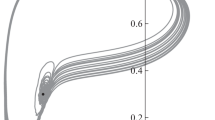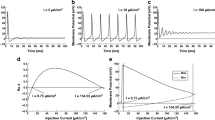Abstract
We have examined the problem of obtaining relationships between the type of stable solutions of the Hodgkin-Huxley type system, the values of its parameters and a constant applied current (I). As variable parameters of the system the maximal Na+(gNa),K+(gK) conductances and shifts (Gm, Gh, Gn) of the voltage-dependences have been chosen. To solve this problem it is sufficient to find points belonging to the boundary, partitioning the parameter space of the system into the regions of the qualitatively different types of stable solutions (steady states and stable periodic oscillations). Almost all over the physiological range of I, a type of stable solution is determined by the type of steady state (stable or unstable). Using this fact, the approximate solution of this problem could be obtained by analyzing the spectrum of eigenvalues of the Jacobian matrix for the linearized system. The families of the plane sections of the boundary have been constructed in the three-parameter spaces (I, gNa,gK), (I, Gm, Gh), (I, Gm, Gn).
Similar content being viewed by others
References
Akoev GN, Alekseev NP, Krylov BB (1988) Mechanoreceptors. Their functional organization. Springer, Berlin Heidelberg New York
Barish ME (1986) Differentiation of voltage-gated potassium current and modulation of excitability in cultured amphibian spinal neurones. J Physiol (London) 375:229–250
Chay TR (1985) Chaos in a three-variable model of an excitable cell. Physica 16D:233–242
Chay TR, Rinzel J (1985) Bursting, beating and chaos in an excitable membrane model. Biophys J 47:357–366
French AS (1987) Removal of rapid sensory adaptation from an insect mechanoreceptor neuron by oxidizing agents which affect sodium channel inactivation. J Comp Physiol A 161:275–282
Harris GL, Henderson LP, Spitzer NC (1986) Developmental changes in cultured amphibian spinal neurones. Soc Neurosci (abstr) 12:952
Hassard B (1978) Bifurcation of periodic solutions of the Hodgkin-Huxley model for the squid giant axon. J Theor Biol 71:401–420
Hodgkin AL, Huxley AF (1952) A quantitative description of membrane current and its application to conduction and excitation in nerve. J Physiol (London) 117:500–544
Hodorov BI (1975) Common physiology of excitable membranes. Handbook of physiology. Science, Moscow
Holden AV, Yoda M (1981a) The effects of ionic channel density on neuronal function. J Theor Neurobiol 1:60–81
Holden AV, Yoda M (1981b) Ionic channel density of excitable membranes can act as a bifurcation parameter. Biol Cybern 42:29–38
Holden AV, Muhamad MA, Schierwagen AK (1985) Repolarizing currents and periodic activity in nerve membrane. J Theor Neurobiol 4:61–71
Huguenard JR, Hamill OP, Enayti EF, Prince DA (1986) Development of Na-conductance in neocortical neurons of the rat. Soc Neurosci (abstr) 12:950
Mironov SL (1984) Modeling of repetitive activity mechanisms of mammalian. Neurophysiol (Kiev) 16:445–451
Noble D (1966) Applications of Hodgkin-Huxley equations to excitable tissues. Physiol Rev 46:1–50
O'Dowd DK, Ribera AB, Spitzer NC (1988) Development of voltage-dependent calcium, sodium and potassium currents in Xenopus spinal neurons. Neuroscience 8:792–805
Rack M, Rubby N, Waschow C (1986) Effects of some chemical reagents on sodium current inactivation in myelinated nerve fibers of the frog. Biophys J 50:557–564.
Rinzel J (1978) On repetitive activity in nerve. Fed Proc 37:2793–2802
Rinzel J, Miller RN (1980) Numerical calculation of stable and unstable periodic solutions to the Hodgkin-Huxley equations. Math Biosci 49:27–59
Stuhmer W, Conti F, Suzuki H (1989) Structural parts involved in activation and inactivation of the sodium channel. Nature 339:597–603
Troy WC (1978) The bifurcation of periodic solutions in the Hodgkin-Huxley equations. Q Appl Math 36:73–83
Vallbo AB (1964) Accommodation related to inactivation of the sodium permeability in single myelinated nerve fibres from Xenopus laevis. Acta Physiol Scand 61:429–444
Wang GK (1984) Modification of sodium channel inactivation in single myelinated nerve fibres by methionine-reactive chemicals. Biophys 146:121–124
Woodhull AM (1973) Ionic blockage of sodium channels. J Gen Physiol 61:687–708
Author information
Authors and Affiliations
Rights and permissions
About this article
Cite this article
Bedrov, Y.A., Akoev, G.N. & Dick, O.E. Partition of the Hodgkin-Huxley type model parameter space into the regions of qualitatively different solutions. Biol. Cybern. 66, 413–418 (1992). https://doi.org/10.1007/BF00197721
Received:
Accepted:
Issue Date:
DOI: https://doi.org/10.1007/BF00197721




